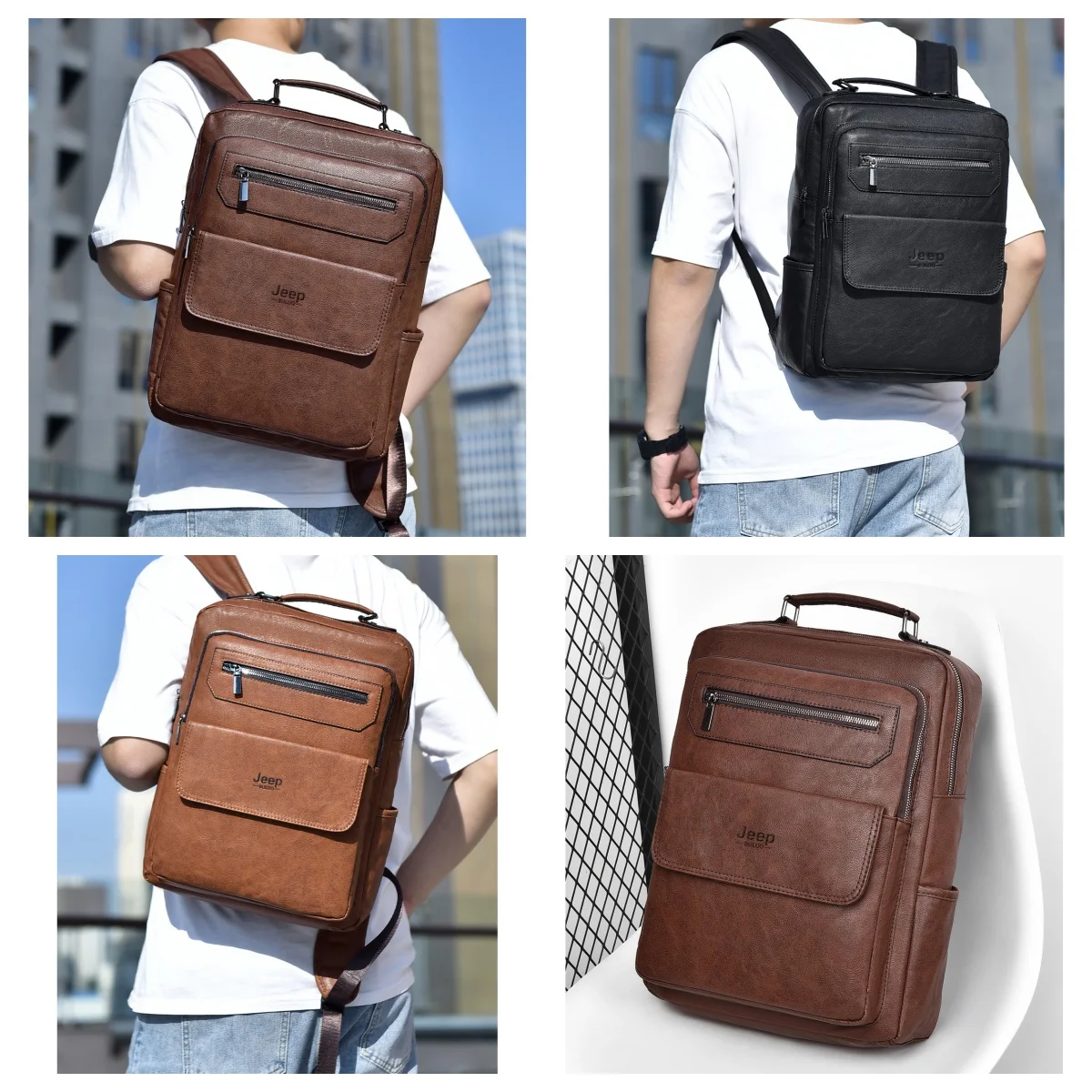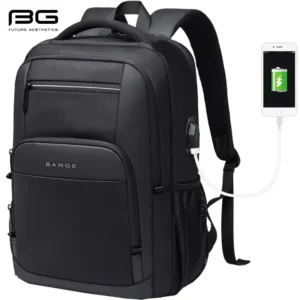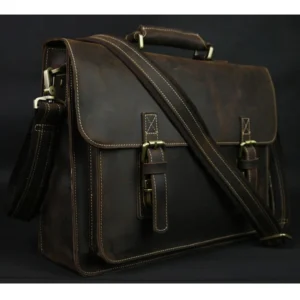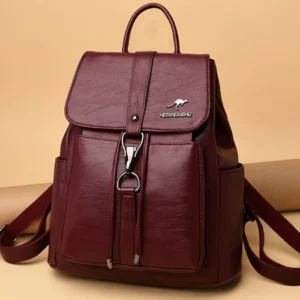In a world of disposable fashion and short-lived accessories, the leather commuter backpack stands as a testament to timeless craftsmanship and practical design. These versatile carriers have earned their place as the go-to option for professionals who value both aesthetics and functionality in their daily journey to work.
A quality leather backpack isn’t just about looking good—it’s about making a smart investment in something that will serve you faithfully for years, perhaps even decades. Unlike synthetic alternatives that wear out after a season or two, premium leather develops a rich patina over time, telling the story of your travels while maintaining its structural integrity.
What truly sets apart durable leather backpacks for commuters is their unique ability to balance professional sophistication with practical everyday use. They transition seamlessly from the boardroom to the coffee shop, offering organization for your tech essentials while making a statement about your personal style.
In this comprehensive guide, we’ll explore everything from leather quality and construction techniques to organizational features and care routines—all designed to help you find the perfect leather companion for your daily commute. While the initial investment might be higher than a standard backpack, the long-term value and timeless appeal make it well worth considering.
I. Why Invest in a Durable Leather Commuter Backpack?
When it comes to daily carry solutions, few materials can match the lasting appeal and durability of quality leather. A well-crafted leather backpack isn’t simply a purchase—it’s an investment that continues to pay dividends over time.
Unlike synthetic materials that deteriorate with age, quality leather develops character through a natural aging process. This patina—a warm glow and subtle color variation that emerges with use—transforms your backpack into a unique piece that tells your personal story. Far from wearing out, a quality leather backpack often looks better after years of faithful service.
The financial wisdom becomes clear when you calculate the cost-per-use over time:
- A $300 leather backpack used daily for 5 years costs approximately 16¢ per use
- A $60 synthetic backpack replaced yearly costs around 33¢ per use when calculated over the same period
Beyond economics, durable leather backpacks’ ultimate guide reveals how these carriers offer unmatched versatility. The same backpack that complements your business attire on Monday can accompany you to weekend adventures on Saturday, adapting to diverse environments while maintaining its structural integrity.
There’s also a sustainability angle worth considering. In our era of fast fashion and disposable goods, investing in a single quality item that lasts for years reduces waste and your environmental footprint. By choosing materials designed to endure rather than to be replaced, you’re making a choice that aligns with more conscious consumption.
For centuries, leather has proven itself as one of humanity’s most reliable materials. From ancient water carriers to modern professional backpacks, leather’s natural strength and flexibility have made it the premier choice for items that must withstand daily use while maintaining their appearance.
Our collection of premium leather work backpacks showcases this perfect blend of enduring craftsmanship and professional aesthetics.
II. Understanding Leather Quality for Maximum Durability
Not all leather is created equal, and understanding these differences is crucial when investing in a backpack that needs to withstand daily use for years to come.
Leather Grades and Their Impact on Longevity
The grade of leather directly determines how your backpack will perform over time:
| Leather Type | Durability | Appearance | Aging Characteristics |
|---|---|---|---|
| Full-grain | Excellent | Natural texture, visible character | Develops rich patina, improves with age |
| Top-grain | Very good | Smoother, more uniform | Moderate patina development |
| Genuine leather | Fair | Varies widely | Limited character development |
| Bonded leather | Poor | Artificial uniformity | Cracks and peels over time |
Full-grain leather represents the highest quality available, using the top layer of the hide with all natural grain intact. This unaltered surface contains the densest fiber structure, offering superior strength and moisture resistance. While initially stiffer, full-grain leather backpacks break in beautifully and develop the most character over time.
Top-grain leather, while still high-quality, has had its uppermost layer sanded away to remove imperfections. This results in a more uniform appearance but sacrifices some durability. It’s still an excellent choice for a quality backpack, though it won’t develop the same rich patina as full-grain.
The term “genuine leather” often misleads consumers. Despite sounding premium, it actually refers to leather made from lower layers of the hide after the top portions have been removed. While functional, these backpacks won’t offer the same longevity or aesthetic aging characteristics.
The Hide Section Matters
The section of hide used in your backpack significantly impacts durability:
- Shoulder leather: Comes from the animal’s shoulder area and offers excellent strength and consistent grain pattern
- Belly leather: More stretchy and less uniform, typically less durable for high-stress applications
Tanning Processes and Their Implications
The method used to transform raw hide into usable leather affects both durability and environmental impact:
- Vegetable tanning: Uses plant-based tannins for a natural process that creates firm leather with excellent aging characteristics
- Chrome tanning: Employs chromium salts for a faster process, resulting in softer, more water-resistant leather
Understanding whether full-grain leather is better for backpacks can help you make an informed decision when investing in your daily companion.
III. Critical Construction Elements That Ensure Longevity
Beyond leather quality, the construction techniques used to assemble your backpack determine how it will hold up under the stress of daily commuting. Even the finest leather will fail prematurely if poorly constructed.
Reinforcement Points
The most critical areas in any commuter backpack are those that bear the most weight and stress:
- Shoulder strap attachments: Should feature double or triple reinforcement stitching and metal hardware anchors
- Top handle connections: Need reinforced stitching and preferably leather-wrapped for comfort and durability
- Base construction: Should incorporate reinforced stitching and potentially protective feet to minimize wear
Stitching Techniques
The humble stitch line represents one of the most common failure points in leather goods:
- Saddle stitching: A traditional hand technique where each stitch is independent, meaning the entire seam won’t unravel if one stitch breaks
- Lock stitching: A machine technique that’s faster but less durable, as one broken stitch can compromise an entire seam
- Stitch density: Quality backpacks feature 5-7 stitches per inch for optimal durability
Hardware Quality
Metal components are often the first to fail on inferior backpacks:
- Zippers: YKK or RiRi zippers with properly sized teeth and smooth operation indicate quality
- Buckles and clasps: Should be solid metal (brass, stainless steel) rather than plated or painted metal
- D-rings and attachment points: Need to be securely riveted or stitched to withstand constant tension
Protective Elements
Thoughtful design incorporates features that prevent premature wear:
- Reinforced corners where abrasion typically occurs
- Metal feet to keep the base elevated from dirty surfaces
- Edge coating or folding to prevent leather edges from fraying
Our men’s leather work backpacks incorporate these construction principles, ensuring they’ll serve faithfully through years of daily use.
IV. Ergonomic Design Features for Daily Commuting Comfort
A backpack can be made from the finest leather and constructed with meticulous attention to detail, yet still fail as a daily commuter if it doesn’t prioritize comfort during extended wear.
Weight Distribution Engineering
How a backpack distributes weight across your body directly impacts comfort during your commute:
- Balanced load positioning: Quality designs center weight close to your back rather than pulling away
- Strategic padding placement: Targeted cushioning at key pressure points prevents discomfort
- Load stabilization: Internal structure prevents contents from shifting during movement
- Weight proportion: The empty backpack should weigh less than 2.5 pounds (1.1 kg) to avoid starting your commute already burdened
Back Panel Design
The part of the backpack that contacts your body deserves special attention:
- Contoured panels that follow the natural curve of your spine
- Ventilation channels or mesh backing to reduce heat buildup
- Semi-rigid structure that prevents contents from pressing uncomfortably against your back
- Smooth leather finishes to prevent clothing snags
Shoulder Strap Construction
Perhaps the most critical comfort element, shoulder straps need to balance professional aesthetics with practical comfort:
- Width between 2-2.5 inches (5-6.5 cm) distributes weight without looking overly technical
- Gradually contoured shape that follows the natural shoulder line
- Adequate padding that compresses under weight without bottoming out
- Adjustment points that stay secure during movement
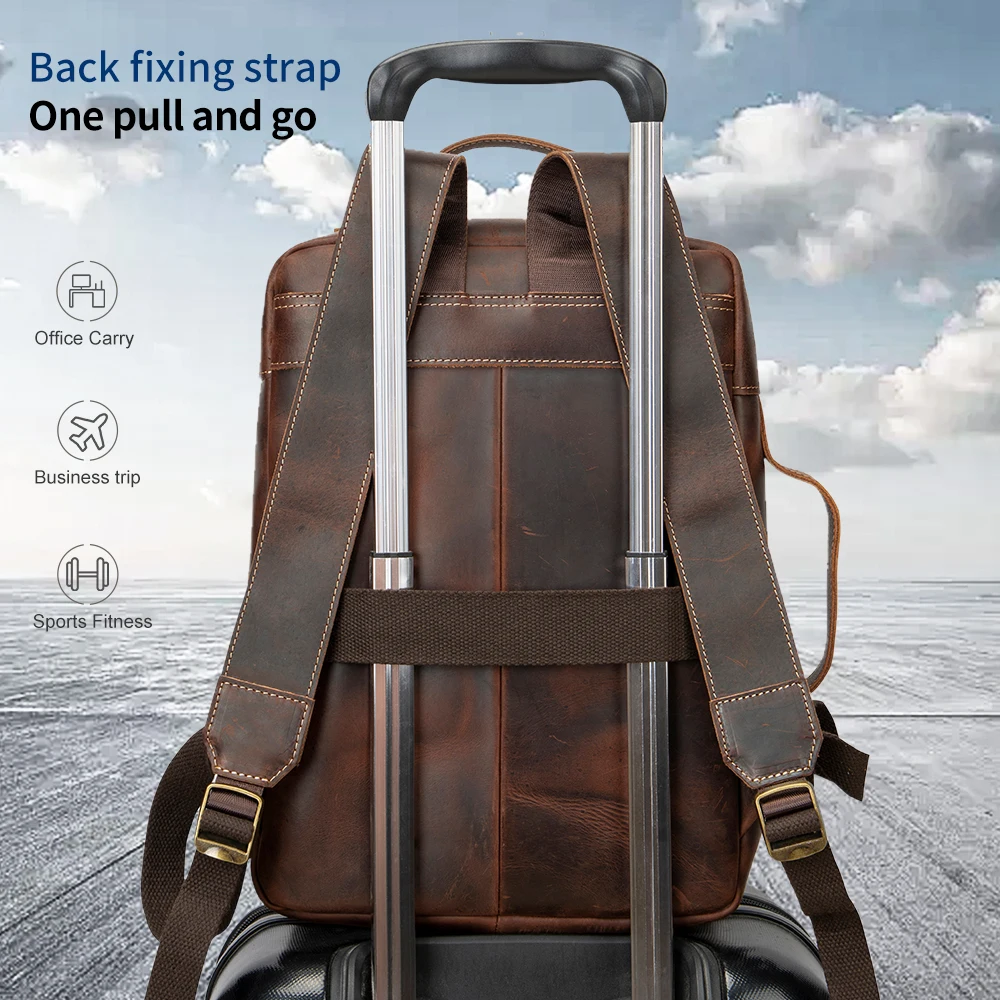
For urban professionals, understanding what size backpack is best for commuting helps strike the right balance between carrying capacity and comfort.
Those carrying laptops daily will appreciate our collection of ergonomically designed leather laptop backpacks that protect your technology without sacrificing comfort.
V. Essential Organization Features for Professional Commuters
The internal design of your leather commuter backpack determines how efficiently you can access and organize your daily essentials. For professionals, thoughtful organization isn’t just convenient—it’s a necessity.
Laptop Protection
The centerpiece of most commuter bags, laptop storage requires careful design consideration:
- Dedicated compartment with suspended bottom to protect against impacts
- Padding on all sides, especially the bottom where drops commonly occur
- Secure closure to prevent laptop movement during commute
- Appropriate sizing: standard compartments accommodate 13”-16” laptops with dimensions of approximately 9.8”×14” (25×35.6 cm) for 15” models
Document Organization
For professionals who still work with physical documents:
- Flat slip pockets that prevent papers from creasing
- Divided sections to separate different project materials
- Reinforced edges to protect documents from damage
- Quick-access external document pocket for items needed during transit
Commuter Essentials Access
Thoughtfully positioned pockets make daily commuting smoother:
- Front or side quick-access pockets for transit cards and phone
- Secure hidden pocket for wallet and valuables
- Keychain attachment point ideally positioned near the top of the bag
- Sunglasses pocket with soft lining to prevent scratches
Technology Management
Modern commuters carry more than just a laptop:
- Cable organization system to prevent tangling
- Power bank pocket positioned for convenient device charging
- Padded tablet sleeve separate from the main laptop compartment
- Small accessories pockets for dongles, adapters, and other tech necessities
Leather backpacks for daily use need to balance these organizational features without adding unnecessary bulk or complexity.
Our collection of 15-inch leather laptop backpacks showcases this perfect balance of protection and organization in a professional silhouette.
VI. Top 5 Durable Leather Commuter Backpacks Worth Your Investment
After understanding what makes a quality leather backpack, it’s time to explore specific models that exemplify these principles. Each selection balances durability, organization, comfort, and style in different ways to suit various professional needs.
The All-Around Professional
This versatile option features:
- Full-grain leather with vegetable tanning for optimal durability
- 15” laptop compartment with additional tablet sleeve
- Expandable capacity from 18L to 24L to accommodate varying daily needs
- Ergonomically contoured shoulder straps with hidden adjustment system
- Water-resistant exterior treatment that maintains leather breathability
- Weight: 2.4 lbs (1.1 kg)
- Dimensions: 16.5”×12”×5.5” (42×30.5×14 cm)
The Executive Carrier
For those seeking premium materials and sophisticated design:
- Hand-selected full-grain leather with polished finish
- Dual-compartment design with dedicated 16” laptop section
- Seven-pocket internal organization system for perfect document management
- Leather-wrapped steel frame opening for easy access and structure retention
- Discreet external access pocket for valuables
- Weight: 2.8 lbs (1.3 kg)
- Dimensions: 17”×13”×6” (43×33×15 cm)
The Compact Commuter
Perfect for minimalists or smaller body frames:
- Top-grain leather with reinforced stress points
- Streamlined profile that maintains professional appearance
- 13”-14” laptop sleeve with protective padding
- Convertible straps for backpack or briefcase carry
- Quick-access front organizer for commuting essentials
- Weight: 2.0 lbs (0.9 kg)
- Dimensions: 15”×10.5”×4” (38×27×10 cm)
The Tech-Forward Design
Engineered specifically for digital professionals:
- Water-resistant full-grain leather treatment
- Dedicated tech organization with cable management system
- USB pass-through charging port for on-the-go power
- RFID-blocking pocket for digital security
- Expansion zipper for additional 20% capacity when needed
- Weight: 2.6 lbs (1.2 kg)
- Dimensions: 16”×12”×5” (40.5×30.5×12.5 cm)
The Weekday-to-Weekend Transition
Versatility for both office and travel:
- Rugged full-grain leather with natural finish
- Padded 15” laptop compartment with tablet sleeve
- Side water bottle pocket discreetly integrated into design
- Pass-through sleeve for luggage handle attachment
- Convertible top that expands for overnight capacity
- Weight: 2.7 lbs (1.2 kg)
- Dimensions: 17”×12”×6.5” (43×30.5×16.5 cm)
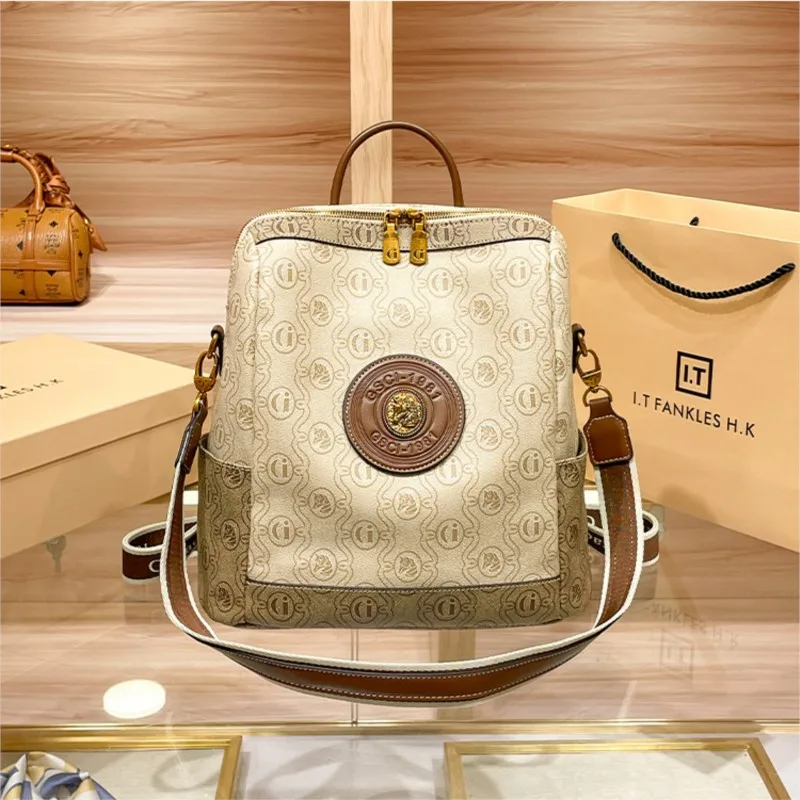
For current recommendations that consider the latest designs, our guide to the best commuter backpacks offers regularly updated selections.
Those looking for truly exceptional craftsmanship should explore our collection of luxury leather backpacks that combine premium materials with masterful construction.
14 Inch Leather Laptop Backpack, Brown Leather Backpack, Men's Leather Backpack, Vintage Leather Backpack
Price range: $177.28 through $199.12 Select options This product has multiple variants. The options may be chosen on the product pageCarry On Leather Backpack, Roll Top Leather Backpack
Price range: $77.76 through $96.48 Select options This product has multiple variants. The options may be chosen on the product pageDesigner Men's Backpack, Men's Leather Laptop Backpack, Men's Leather Work Backpack
Price range: $158.04 through $160.04 Select options This product has multiple variants. The options may be chosen on the product page15 Inch Leather Laptop Backpack, Leather Briefcase Backpack
$332.96 Select options This product has multiple variants. The options may be chosen on the product page17 Inch Leather Laptop Backpack, Men's Leather Travel Backpack, Men's Leather Work Backpack
Price range: $106.28 through $143.88 Select options This product has multiple variants. The options may be chosen on the product pageLuxury Leather Backpack, Small Leather Backpack, Women's Leather Backpack
Price range: $137.48 through $138.28 Select options This product has multiple variants. The options may be chosen on the product page
VII. Proper Care Routines to Extend Your Backpack’s Lifespan
The way you treat your leather backpack directly impacts its longevity. With proper care, a quality leather backpack can last decades rather than years.
Daily Maintenance Habits
Simple daily practices that make a significant difference:
- Empty your backpack completely at day’s end to maintain its shape
- Wipe down exterior with a soft dry cloth to remove dust and pollutants
- Allow proper ventilation rather than storing in confined spaces
- Avoid overstuffing which strains seams and stretches leather
Seasonal Care Calendar
Regular maintenance prevents problems before they start:
- Monthly (minimum): Light cleaning and inspection of stress points
- Quarterly: Deep conditioning to maintain leather moisture balance
- Biannually: Hardware inspection and treatment with appropriate metal protectant
- Annually: Professional assessment and treatment for any developing issues
Addressing Common Issues
Quick response to these common problems prevents permanent damage:
- Water spots: Allow to dry naturally, then treat with leather conditioner
- Scratches: Most minor scratches can be buffed out with conditioner
- Color fading: Regular conditioning prevents excessive fading
- Hardware issues: Address immediately to prevent stress on leather components
For best results, store your backpack on a proper stand or stuffed with acid-free tissue when not in use for extended periods. Never use harsh chemicals or excessive heat when treating leather.
Our comprehensive guide on leather commuter backpack care tips provides detailed guidance for specific leather types and finishes.
For step-by-step instructions on maintaining your investment, our article on how to clean leather backpacks offers techniques suitable for different leather finishes.
VIII. How to Identify Signs of Quality When Choosing Your Backpack
Distinguishing exceptional craftsmanship from merely good-looking design requires attention to specific quality indicators.
Visual Assessment Techniques
Even without touching the product, quality clues are visible:
- Edge finishing: Clean, even coloring on all edges
- Stitching uniformity: Perfectly straight lines with consistent spacing
- Hardware mounting: Reinforced attachment points without puckering
- Surface texture: Natural variation in full-grain leather versus artificially uniform appearance
- Color consistency: Subtle natural variation rather than perfectly even coloring
Tactile Evaluation Methods
When possible, handling the backpack reveals much about its quality:
- Weight: Quality leather has substantial feel without excessive heaviness
- Flexibility: Good leather should flex naturally without feeling flimsy
- Texture: Authentic full-grain leather has subtle natural variations
- Hardware operation: Zippers, clasps and buckles should operate smoothly
- Seam strength: Gently pull seams to check for sturdy construction
Warranty Considerations
A manufacturer’s guarantee often reflects their confidence in their product:
- Comprehensive warranties covering construction defects
- Reasonable repair policies for normal wear and tear
- Clear distinction between manufacturing defects and user damage
- Reputation for honoring warranty claims without excessive hassle
When shopping online, detailed product descriptions, high-resolution photography, and transparent materials information help compensate for the inability to physically inspect the product.
Our guide on how to choose a rugged leather backpack provides additional insights into evaluating quality when making this important investment.
IX. Balancing Weather Protection and Leather Integrity
Leather’s natural properties create an inherent tension between weather resistance and maintaining the material’s breathability and natural aging process.
Waterproofing Options
Different protection methods offer varying levels of weather resistance:
- Wax-based treatments: Provide good water resistance while allowing leather to breathe
- Silicone sprays: Offer excellent repellency but may affect patina development
- Oil treatments: Enhance water resistance while conditioning but may darken leather
- Acrylic sealers: Create strong barrier but can trap moisture and prevent natural aging
Climate Considerations
Your local weather patterns should influence your approach:
- Rainy climates: Prioritize regular waterproofing treatments
- Dry climates: Focus on preventing leather from drying out with conditioners
- Snowy environments: Protect against both moisture and salt damage
- Extreme heat: Guard against sun damage with UV-protective conditioners
Finding Balance
The sweet spot comes from matching protection to your specific needs:
- Consider your commuting method (walking vs. driving)
- Evaluate your typical exposure time to elements
- Balance aesthetic preferences with practical protection
- Remember that some patina development is desirable and natural

For professionals who travel frequently, our carry-on leather backpacks incorporate weather-resistant features without compromising leather quality.
X. Is a Leather Commuter Backpack Right for You? Decision Factors
Before investing in a premium leather backpack, consider these key factors to determine if it matches your specific needs and lifestyle.
Commuting Method Assessment
Your daily transportation significantly impacts backpack requirements:
- Public transit users need security features and comfortable standing wear
- Cyclists require stability and potentially weather resistance
- Car commuters might prioritize organization over comfort features
- Walking commuters need optimal weight distribution and comfort
Professional Environment Compatibility
Consider your workplace culture and expectations:
- Traditional corporate settings often favor subdued, classic designs
- Creative industries may welcome more distinctive styling
- Client-facing roles might require more formal presentation
- Field work demands greater durability and weather resistance
Maintenance Reality Check
Be honest about your willingness to maintain your backpack:
- Do you enjoy caring for quality items?
- Will you remember regular conditioning and cleaning?
- Are you likely to address small issues before they become problems?
- Do you have appropriate storage space for proper maintenance?
Alternative Considerations
For some users, alternatives might better suit specific needs:
- Waxed canvas offers heritage appeal with different maintenance requirements
- High-end synthetic materials provide maximum weather protection
- Mixed-material designs can balance aesthetics, maintenance, and functionality
Our comprehensive guide on long-lasting leather commuter bags explores these considerations in greater depth, helping you make an informed decision for your specific circumstances.
XI. Frequently Asked Questions About Leather Commuter Backpacks
How much heavier is a leather backpack compared to synthetic alternatives?
A quality leather backpack typically weighs 2-3 pounds (0.9-1.4 kg) empty, about 0.5-1 pound more than comparable synthetic backpacks. This difference becomes less noticeable with proper ergonomic design and weight distribution.
How long does it take for a leather backpack to break in?
Most full-grain leather backpacks require 2-3 weeks of daily use to begin softening, with complete break-in achieved after 1-2 months. Top-grain leather typically breaks in faster, usually within 2-3 weeks of regular use.
What’s the realistic lifespan of a quality leather backpack?
With proper care, a high-quality full-grain leather backpack can last 10-20+ years of daily use. Many users report their leather backpacks looking better after years of aging than when first purchased due to natural patina development.
Can a leather backpack transition between formal and casual environments?
Yes, this versatility is a key advantage of leather backpacks. Choose minimalist designs in neutral colors (black, brown, tan) for maximum versatility. Some models offer removable elements to adjust formality levels as needed.
Are leather backpacks appropriate for air travel?
Most leather commuter backpacks meet carry-on requirements for domestic flights. Look for models with luggage pass-through straps and TSA-friendly laptop compartments that open flat for easier security screening.
For more information about the benefits of investing in quality leather, our article on exceptional benefits of sturdy leather backpacks addresses common questions.
XII. Avoiding Common Pitfalls When Shopping for Quality Leather Backpacks
Even informed shoppers can fall prey to misleading marketing when purchasing leather goods. Stay vigilant for these common issues:
Misleading Terminology
Watch for these potentially deceptive descriptions:
- “Genuine leather” sounds premium but actually indicates lower quality
- “Leather-like” or “leather-faced” typically means only a thin outer layer is leather
- “Handcrafted” may refer to only certain components rather than the entire backpack
- “Premium” has no standardized meaning in the leather industry
Quality Masking Techniques
Some manufacturers use these methods to disguise lower-quality materials:
- Heavy embossing to hide inconsistent grain or reconstituted leather
- Excessive pigmentation that conceals natural leather characteristics
- Artificial grain patterns pressed into split or bonded leather
- Thick paint-like finishes that crack over time
Price Reality
While price isn’t a perfect indicator of quality, be wary of:
- Full-grain leather backpacks priced under $150, which typically indicate compromises in material or construction
- Hidden costs through poor durability and early replacement needs
- “Lifetime warranty” claims without clear definition of covered issues
- Dramatic discounts that suggest artificial price inflation
When shopping online, prioritize retailers who provide detailed information about leather type, tanning methods, hardware specifications, and construction techniques—transparency often correlates with quality.
XIII. How to Test Your Backpack’s Durability Before Committing to Daily Use
Before fully integrating your new leather backpack into your daily commute, perform these simple tests to identify any potential weaknesses:
Load stress test: Fill the backpack with books or weights approximating your typical daily load, then examine all seams and attachment points for signs of stress.
Hardware function check: Open and close all zippers, buckles, and clasps at least 20 times to ensure smooth operation and catch any early signs of weakness.
Strap security assessment: While wearing the loaded backpack, twist and move as you would during a typical commute to test strap attachment security.
Water exposure test: Place a few drops of water on an inconspicuous area to observe absorption rate and validate water resistance claims.
Interior durability check: Run your hand along all interior seams and edges to check for rough spots that might damage electronics or catch on clothing.
Conduct these tests within your return window period but after deciding you like the backpack enough to keep it. Address any concerns with the manufacturer immediately rather than hoping they’ll resolve with use.
XIV. The Environmental Impact of Choosing Quality Over Quantity
The environmental footprint of leather goods extends far beyond their production, encompassing their entire lifecycle:
- A single well-made leather backpack that lasts 10+ years creates significantly less waste than replacing synthetic backpacks every 1-2 years
- Quality leather goods can often be repaired rather than replaced, further reducing environmental impact
- Traditional vegetable tanning uses natural materials rather than chromium compounds
- Properly sourced leather makes use of hides that would otherwise become waste products from the food industry
Look for manufacturers who embrace responsible practices:
- Transparent supply chain information
- Natural tanning methods or certified eco-friendly chromium processes
- Repair services that extend product lifespan
- Ethically sourced materials with relevant certifications
By investing in quality leather goods designed for decades of use, you’re participating in a more sustainable approach to consumption—choosing fewer, better things that don’t need frequent replacement.
XV. Conclusion: Making Your Investment Count
Throughout this guide, we’ve explored the many facets that make a leather commuter backpack worth the investment—from superior durability and aging characteristics to thoughtful organization and proper care routines.
The true value of a quality leather backpack reveals itself gradually, as daily use transforms it from a pristine accessory into a trusted companion that carries not just your essentials but also the subtle marks of your journey. Unlike disposable alternatives, these bags improve with age, developing a rich patina and conforming to your specific usage patterns.
Before making your selection, take time to assess your specific needs:
- Consider your daily commute and the features that would make it more convenient
- Evaluate your professional environment and the aesthetic that would integrate seamlessly
- Be honest about your maintenance habits and choose accordingly
- Focus on construction quality over brand names or trendy features
The perfect leather commuter backpack balances form and function in a way that serves your specific needs while offering the timeless appeal that only quality leather can provide. When chosen carefully and maintained properly, it becomes more than just a way to carry your belongings—it becomes a signature piece that represents your commitment to quality and longevity in an increasingly disposable world.

